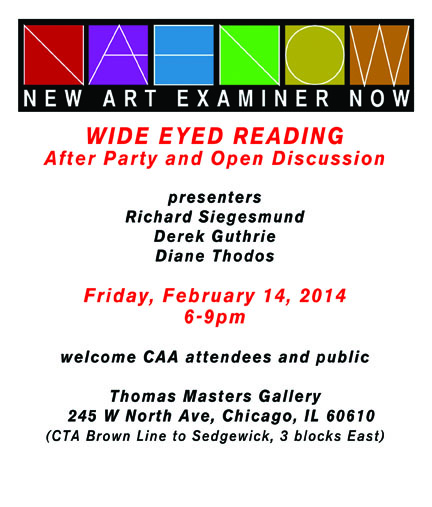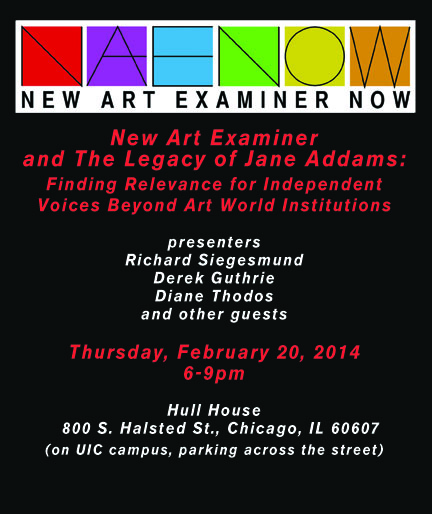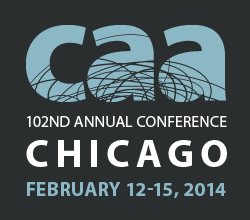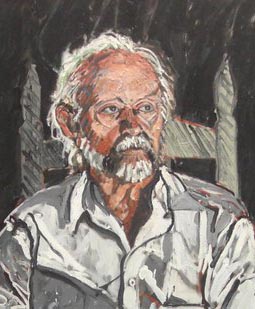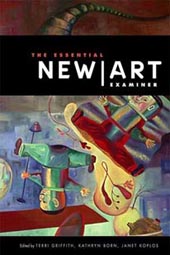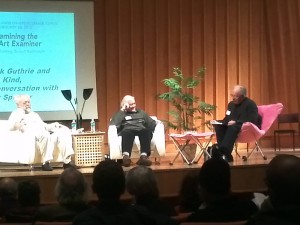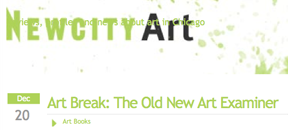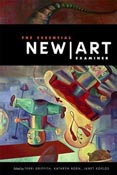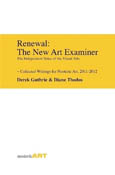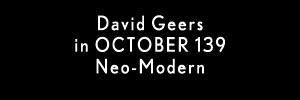
On Chicago Art Criticism: A Panel Discussion
SUNDAY, APRIL 15, 2012 - 1:00pm - 5:00pm
New Art Examiner co-founder Derek Guthrie and an intergenerational panel of local art writers discuss the historical significance and future of art criticism in Chicago. The dialogue touched upon the current discourses of modern and postmodern approaches to art criticism, art writing, new arts journalism, institutional authority and influence (art schools, art museums, etc.) as well as contemporary art strategies that are shaping culture now. The perceived goal of this event was to establish certain histories and commonalities that can move our city forward.
Panelists included: Kathryn Born, W. Keith Brown, William Conger, Andrew Falkowski, Derek Guthrie, Annie Markovich, Bert Stabler, Diane Thodos, and Lauren Weinberg.
link to Evanston Art Center
__________________________________________________________________________________

At the end of the panel discussion Derek Guthrie read the following statement which has been published in Neoteric Art.
My following remarks are only an overview. They are today’s suggested topics for debate. There may be conclusions embedded, but if so they are spare and not well argued for reasons that I have just stated.
Criticism is only talking about art. It is the sharing of opinion. It may be philosophy, ethics, aesthetics, critical theory, cultural policy, literature, poetry, or polemic but it is a requirement of a civilized and a thinking society.
The art world is in a mess. The mess is not different from the mess that our society is in. This is a political issue. It is a social issue. It is a matter of the enfranchised and the disenfranchised. It is a matter of how money is distributed. The art distribution system has to be run on the same principles as how the political system works. Whether our systems in the UK and the USA are good for art is the question. The other question that is available – is art possible or has art died? The successful artists are the super stars like Damien Hirst and Jeff Koons. Whether they are worthy or not is the simple question that is in all of our minds. If we agree or disagree and the reasons why we agree or do not is not only our response to the individual pieces but also a response to the system and power which appoints them as the most significant artists of our time. The issue is complex as is the response to the approved artists places the respondent in a particular position – that he or she will naturally gravitate to others who share the same taste and ways of art is part of social definition. We may change our minds. That can be interesting and could be art criticism.
Our media is dominated by political discussion. Our media is not dominated by cultural discussion and when it does respond it will be inside the tribe of choice – Democrats or Republicans. Somebody once said if you stand in the middle of the road you are hit by traffic moving in both directions.
I think it is reasonable to surmise that many of us, maybe nearly all of us, had the hope – maybe naively – that involvement with art would take us into a world or a way of life that would be free from the veniality of a class-dominated society. The romance and discovery of art, we hoped, would transport us into a mythical world of enlightened people. The 19th century attempt to provide an environment for creative people was the salon. This idea became democratized and was extended into Parisian cafe society – and still today we dream of that dream that in imagination lives. It won an Oscar in Hollywood. The museum and even art departments are the modern attempts to continue and keep alive this ideal, but have betrayed it and are no longer open to people from all walks of life, just those with deep pockets and those who can afford to buy a BFA or MFA. However it was the achievement of the New Art Examiner that we made a little community that loved art and shared enthusiasm with others by the time-honored process of writing. We may have made mistakes but we made a contribution that now cannot now be denied. The most gratifying thing to me resulting from the publishing of the anthology was that it documented how the NAE carried a variety of voices by different editors and writers and removed the demonization of its founding editors. Liberal America emphasizes the idea of pluralism but is sometimes slow to recognizing it, particularly when it is not institutionalized.
The radicalism of the NAE is that it was not afraid of discourse and that ethic should not be considered radical. Maybe it is in present day America but there are still some people who like to think that free speech is an American value. The NAE respected passion. Today the pressures of the recession are activating voices of protest, namely the Occupy movement and a scattering of web sites, finding a space for new voices and seeking a new status quo – and passions are increasing.
The art system is not transparent and while this is so artists will have to live in “cuckoo land” as they operate in a world of which they know very little or nothing – yet they desperately search for approval within it. Artists, unless successful, live in a ghetto. Their hope is that their own significance and originality will filter up. Status and respect will be achieved and then they will move into an “up market” ghetto. This system has been well defined for decades. New York and London have art magazines and a market with academic infrastructure that certifies significant art and distributes it to the regions that usually follow the latest fashion of the avant-garde. Regional centers do not have the critical firepower to establish a new development or wrinkle in the culture of the avant-garde, yet regional art in Chicago made a heroic effort to work inside their own values and culture even though eventually it was not enough. As Phyllis Kind once said to me “There are twenty or thirty collectors of this art in Chicago. I have sold 7 or 10 pieces to all of the collectors. The market has reached its potential and I have to move to New York. I cannot mark up the prices any more.”
In the meantime the same collectors, naturally, were also buying the big name artists made in New York and attending the sales at Sotheby’s. Buying and selling – when it is right to get in and out of the market – is the trick of Futures Marketing. Wildenstein had established an international major New York gallery in the 40’s and 50’s and had a branch in Chicago. It closed its doors in Chicago as the proprietors sold more art to Chicago collectors from the New York gallery than from Chicago.
So the game is like casino betting – maybe with love on loaded chips. The recent collapse of Wall Street is nominated as casino capitalism. That is when rich people – the bankers and the investment houses – are playing with little people’s money along with the failure of government to protect the average saver. The museum is the casino and/or investors club that is the power and the secret information available to social networks of trustee collectors and their helpers the curators. The museums are not regulated and insider trading is given a free license under the rules of not-for-profit status and tax law. There is always a power struggle around art. Particularly today as we are not sure what art is. It is like the dollar being removed from the gold standard and the market deciding its value. The market tells us that McDonald’s is good for me and tasty. We all know it is junk food. The question is, is Jeff Koons junk food for the mind? As Jeff Koons says “the market is the critic.” Talking about hamburgers I cannot but recoil remembering when the Queen of England visited the USA a few years ago. The usual celebrations were put in place. To introduce the Queen to American cuisine the White House decided to provide her, in the Rose Garden, with the best cuisine America had to offer: the hamburger. Andy Warhol, with his genius for the social observation of celebrity culture, pointed out that the hamburger was very democratic as it was enjoyed by everybody – even the Queen of England. The sharing of bad taste is democratic. We are all human but the reaching for something else is of interest and the belief that there is something better is the dream of significant dreamers.
Jane Addams Allen wrote an authoritative article in November 1981 reprinted in The Essential New Art Examiner. She discussed the declining power of the art review well ahead of her time, stating that the independent critic or review was obsolete. The forces of marketing and distribution were too strong. James Elkins wonders Whatever Happened to Art Criticism? – the title of his 2003 book. It is a pity that he did not read Jane’s article. Raphael Rubenstein edited a great book Critical Mess in which leading critics contributed essays pointing to the problems of critics. I quote from Eleanor Heartney – incidentally a writer now in New York – who started her career at the New Art Examiner. Her essay “The Crisis in Art Criticism” is in the book Critical Mess:.
There are practical problems. The venues for art criticism are limited and impose restrictions on what may be discussed. Art magazines operating as trade journals and dependent on advertising for revenue tend to focus on reviews of artists or exhibitions that are in the public eye, while art coverage in general interest publications has a strong bias towards celebrity and entertainment. Academic journals, read by few, often unreadable, and operating largely as tenure generators, are more like private clubs than forums for genuine debate and discussion. As a result certain kinds of essays are never written simply because there is no place to publish them.
There is always a power struggle around art. To pretend otherwise is folly. Some simply believe that wealth does not guarantee discrimination and a greater ability to judge art.
We are here today to talk about the New Art Examiner in the past and whether it possible that it could have a future. The odds do not look good. I would loved to be talked out of this conclusion. It is not for me to say that the blood sweat and tears that the Examiner cost can be repeated. In 1974 everybody thought it would not last more than few issues. If it was to happen again the name and reputation of the New Art Examiner is not in doubt. It now has meaning and is a proven entity. Does that mean support? I do not know. I can guess it may mean some support in the form of grants, and that’s complicated as the giving of grants have their own politics. Getting a grant is like getting an endorsement and that is a question of convincing the giver one has the right social theology and the possibility of success.
The overriding point is that Chicago is not a good place. It was not a good place in 1974. But somehow something happened and we survived. The story of the NAE is partly told in the anthology The Essential New Art Examiner. It is not a history but it has made a history possible. As I wrote in the introduction all of this is the result of community support. The NAE would have disappeared from history if it were not for the vision of one of the anthology’s editors Kathryn Born. Kathryn took the enormous step of commitment to create this book. I learned two nights ago that Richard Seigesmund and Janet Koplos will join forces to write a history of the New Art Examiner and a third collaborator – an art historian – will probably join the team.
What I am moving towards is the reluctance and hostility of the Chicago art hierarchy – museums and art departments which have a studied indifference towards the New Art Examiner or even the idea of criticism outside their walls.
———-
The “Second City” is an empty city. It is also a part of American culture and that is draining away. I do not think that an original and innovative voice can make its way through the labyrinth of procedures – of social networking and deal making, the demands of the market, the politics and academic trading of tenure which in spirit is no different from the trading between congress and lobbyists: money for votes. I am not sure it is a manifested destiny. We all know that the last four governors of the state of Illinois as well as the chief of police have been indicated for corruption and torture. This always leaves the unanswered question – how does this affect the civic life of the citizen? I think it empties it out and makes the situation a vacuum. I believe this sets in place a destiny in which there is no filtering up, only filtering down. This is not good news for those outside the system. It is good for those that mange the system. As Sam Gilliam the Washington D.C. artist once said to me “There are two kinds of artists – ones that move the system and the ones that fit into the system.”
“Manifestation of human achievement” is the Oxford English dictionary’s definition of culture. Chicago around the turn of the century contributed remarkable architecture to American culture. Chicago is the living museum of early modern architecture – the urge to monumentality can be achieved inside the space of real estate. Heroic materialism in its glory adorns the cit and the lakeshore with the exception of the Trump Tower. But what has happened in the alleyways between the tall buildings in the shadows? Gangsters, Nelson Algren, Mayor Daley, Ivan Albright, the Chicago Imagists and the Monster Roster. They all struggle with the dark or are dark. I leave that distinction to you.
We are talking inside the context of Chicago. Chicago is in part my context but I have other contexts as did Jane Addams Allen. The plight of contemporary art is well discussed. Art supports a huge industry of education, trading and investment. This system has been captured by celebrity culture. The strains in our political system are the demands of celebrity culture put on the political system. Hollywood and the White House are interchangeable on and off the screen. Celebrity culture is a culture of mass media, something that Andy Warhol and Jeff Koons analyzed very well and cashed in on.
The difference between the mass market and the museum along with the educational system is that museum and educational system are meant to respond to a different voice than the norm: those that seek something better than the banality or the hum drum of the market. The authority given to those systems, with their tax exempt status as not-for-profit, is based on the idea that thinking and creative production are to be considered inside the idea of the humanities, which is not determined by the strategies of marketing successful products. Yet the market and the academic/museum coalition are in bed with each other. The Republican primary well illustrates the process of making a product or a person to fit into the White House. The marketing is more important than the product. American democracy is degenerating and if that is so then so will the culture. We will have to look to those who resist and art history provides many sterling examples of this to think about. Culture will degenerate unless the subtle tyranny of the media and PR is recognized. Orwell called it “Big Brother” and also pointed to the inventible lust for power in his book Animal Farm where he wrote “All animals are equal but some animals are more equal than others.”
Patronage of art is hoped to have discrimination. It is fashionable, and has been since New York became the world center of contemporary art, to recognize the artist as heroic resister even if he or she is not. Jackson Pollock was a suitable icon during the Cold War as Harold Rosenberg pointed out with his words “the tradition of the new” and “the herd of independent minds.” The new emerging culture may have had built-in defects. I cannot miss this occasion to point out that it was the Partisan Review, a small left-leaning publication, that provided the platform and thinking which developed modern art criticism in the US.
Whatever sophisticated resources mustered by the MCA and the Art Institute they completely missed out on the originality of thinking and the contribution of the New Art Examiner to Chicago culture and the long list of professional writers and academics that emerged from the publication. They responded with usual American or Chicago fear of originality or “difference” as it might be destructive or belong to the other side, usually applied to intellectuals whose primary purpose is not love of money. As George Bush the second said “You are either for us or against us.” I think this thinking is a form of fascism – as is water boarding. The phrase originally came from Lenin.
———-
Chicago is the same town that once carried a literature emanating from large feelings to all men in all tongues, for it was here that those arrangements more convenient to owners of property than to propertyless were most persistently contested by the American conscience. The following words are courtesy of Nelson Algren:
Chicago has progressed, culturally, from the “Second City” to the second-hand city. The vital cog in our culture is not the artist but the middleman whose commercial status lends art the aura of status when collected into a collection of originals. The word “culture” now means nothing more than approved. It is not what is exhibited that matters as much as where – that being where one meets the people who matter.
The people who matter control money. The New Art Examiner survived on a shoestring. A fact of life once observed by Franz Schultz in the MCA catalog Art in Chicago from 1996 was that “the New Art Examiner was the most important thing to have happened in the Chicago scene in the 70’s and 80’s.” He also wrote that “Chicago is an ass hole but it is my ass hole.” I will agree with Franz except his very last observation.
I do not know the details of the death of the New Art Examiner. It became comprised as it moved into the academic orbit – or more to the point the art historians tenure club. I know that it gave up its original cover slogan The Independent Voice of the Visual Arts to be replaced by The Voice of Midwest Art. Jane Addams Allen and myself were elevated to the high sounding title of Publishers Emeritus. But this was a ritual sacrifice in the same way that an animal which is to be slaughtered is adorned with flowers. It signaled our death in the NAE as we could no longer contribute as writers. Even with this caveat it remains true that many excellent and valuable articles were published – but the orbit became restricted.
So the NAE was born as a resistance to censorship and it died when it exercised censorship.
As a matter of interest the 1975 article in The Essential New Art Examiner written by Jane Addams Allen and myself entitled The Tradition was the same article that was lifted three days before publishing by Art News and later accepted by Studio International. I do not think the editors of The Essential New Art Examiner realized that this article was such a cause célèbre. Its content is sane and not destructive. Today it causes no anxiety.
I have to be careful here as I do not want to be seen as whining. The NAE, in spite of its hardships, gave us a dynamic life and a little footnote in history. Occasionally I am invited to give lectures, even if sometimes for no money. I wish to avoid seeming to be the presence as an OLDIE trying to keep in the spot light after his time has passed. I would like to quote from Nelson Algren again – his words are better than mine:
Make the Tribune best seller list and the friends of American writers the friends of literature, the friends of Shakespeare and the friends of Frank Harris will be tugging at your elbow, twittering down your collar, coyly slipping a little olives into your martini, or drooling flatly into your beer with the drollest sort of flattery and the cheapest sort of praise, the grade reserved strictly for proven winners.
But God help if you are a loser and unproven to boot. The bushy tails will stone your name.
Victoria Waxman has made sure we have not made the Tribune list.
———-
Times have changed and online culture is a new element in our lives. However personally I do not think it will eliminate serious print culture. A book or a magazine is an object and has a physical presence. It is not fugitive. A magazine or book has an immediate presence when on the bookshelf.
If the NAE is to return it will have to have an online site. I may have a site donated in England, but the heart will be the community of the office that works together to collect information, discuss information, share networks, and have a place for writers to visit and above all gossip. Even if the new New Art Examiner produces only 4 or 6 issues a year it will be a start. Here I would like to say with emphasis that the NAE did not claim authority other than it collected writers of authority. It was also quite happy to give equal space to all. In this it was democratic. Not that many availed themselves of this opportunity to do so. Roger Brown did once. He called me “Fat Filth.”
Artists, even if not original, are more important than collectors. Artists make art and collectors arrive after the art is made, though I have met some collectors whose company is preferable to some artists.
The system correctly assumes there is a permanent supply of artists just like oil. Oil will run out but artists will not, therefore they have no value. BFA’s and MFA’s are an attempt to gain value. They are the inflow that is needed to feed into the art machine to make sausages of cultural products – as Marcel Duchamp implied with READY MADES – which, if well packaged , adding little spice of publicity, will sell.
———-
The simple point is that Chicago needs a dynamic art publication that is more than boosterism and that has a national art reach, or now an international art reach as the world is shrinking. If there is to be a new NAE it will have to avoid Xenophobia and not be afraid of the local provincial power base.
I dream of a new New Art Examiner in part like the old one – Without Fear or Favor – that will have roots in Chicago but would deal with the wider world of contemporary art in which a new critical language can be found which will be able to review an artist showing anywhere and that will make sense to a reader living far from the exhibition. This is a tall order.
An interesting quirk to be learned from the anthology is that the editors chose two articles by Frank Pannier, an impossible man and an alcoholic who died early. His passion and intelligence still lives – a rare combination. Frank, unlike his colleagues, was not afraid. His fight for authenticity probably killed him but it is a contribution that would have been silenced except for the reprinting of his views. The point is that Frank fought his corner and most are afraid to do so. In conclusion I must say this – that Chicago is so retarded that there is not even a working archive of the NAE in place. Therefore future scholarship and research is denied.
I want to conclude with the words of the only artist in Chicago who has had a street named after him.
Where have all the people gone? Electronic shadows of former selves watching video screens, ignoring the right of refusal….
Perception, or that we experience through our sensory apparatus, is being affected by the rapid acceleration of media-related technology. Our view of the world is changing as the “global environment ” expands through media accessibility and the information reservoir gets deeper. My belief is that these elements (good or bad) have woven their way into the collective fabric of our lives. I also believe that any artist always works within the context or conditions that are indigenous to his or her own time and, in doing so, reflects the energy, temperament and attitudes of that climate.
Paint may seem like an outmoded medium but the human imagination is endless.
Ed Paschke – Speakeasy, February 1981, The Essential New Art Examiner.
———-
If the imagination can be fired again and if there is enough momentum I would like to help out. I still have a network of active art thinkers who will respond to a call from the New Art Examiner as writing for the New Art Examiner is considered prestigious. I can help out with my experience and knowledge of publishing. I cannot lead it. It has to be the driven by a new generation.
Thank you.
About
Derek Guthrie lived and worked in St Ives as a successful painter in the 60s before moving to Chicago and co-founding, in 1973, the New Art Examiner, an influential American art magazine which continued production until 2002. He moved back to Cornwall in 1996.
|
![]()
